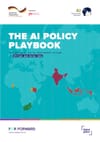⚡ Quick Summary
This Playbook is field-tested guide for AI policy design. Aimed at policymakers and civil society, it translates high-level AI principles into legislative options, sample provisions, and strategic levers for advocacy. The 2024 edition adds new material on generative AI, API-level governance, and international coordination. Structured into four action areas—transparency, accountability, data stewardship, and red lines—the Playbook distills hundreds of global policy experiments into adaptable templates. It’s not a model law; it’s a modular kit to mix, match, and localize. From procurement standards to public registers, it equips readers to build guardrails where laws lag behind.
🧩 What’s Covered
The Playbook is organized around four “action areas” that define a rights-based approach to AI governance:
- Transparency & Explainability
- Includes model documentation templates, audit traceability, and public disclosures
- Offers sample provisions for algorithmic registers, impact assessments, and documentation obligations
- New in 2024: API labeling of model capabilities, data lineage requirements for LLMs
- Accountability & Liability
- Covers human oversight, appeals mechanisms, and enforcement capacity
- Provides language for liability allocation in the AI value chain (developers vs. deployers)
- Highlights risk-tiering frameworks and enforcement triggers
- Data Stewardship
- Promotes data rights, access to training data, and participatory data governance
- Includes sample clauses for data sharing, trust models, and data fiduciaries
- Discusses open-source model provisions and transparency incentives
- Limits & Red Lines
- Proposes policy options to prohibit certain AI uses: biometric mass surveillance, emotion recognition in public spaces, manipulative personalization
- Includes risk escalation pathways and dynamic safeguards for generative models
Other Key Content:
- Playbook Builder Matrix (p. 4–5): A visual index that maps action areas to policy levers
- AI Lifecycle Map (p. 9): Aligns interventions to stages of development and deployment
- 40+ Real-World Examples from Africa, LATAM, EU, and U.S. cities
- How to Use It guidance for local vs. national policymakers, tech activists, and regulatory drafters
💡 Why it matters?
There’s no single recipe for AI legislation—but there are recurring ingredients that work. This Playbook gives non-experts a handle on how to turn AI principles into enforceable, adaptable laws. It empowers Global Majority actors with sample language and examples, without defaulting to EU/US paradigms. With growing pressure on lawmakers to “do something” fast, this is a rare tool that favors strategic action over knee-jerk bans or toothless principles.
❓ What’s Missing
- Enforcement Strategies: Limited guidance on institutional setup or regulator capacity
- Cross-border Interoperability: Few recommendations on aligning across jurisdictions
- Technical Depth: Simplified explanations of LLM-specific risks may need bolstering for expert audiences
👥 Best For
Local and national legislators crafting first-gen AI laws
- Advocacy groups pushing for meaningful transparency or red lines
- Think tanks translating AI principles into public policy
- Civil society coalitions in the Global South seeking ready-to-adapt templates
- Policy teams in ministries, parliaments, or digital agencies
📄 Source Details
Title: The AI Policy Playbook: 2024 Edition
Author: AI & Society Program
Date: 2024
Length: 46 pages
Format: Modular guide with sample clauses, case studies, and templates


